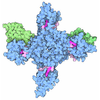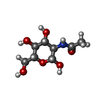+ Open data
Open data
- Basic information
Basic information
| Entry | Database: PDB / ID: 9ith | ||||||
|---|---|---|---|---|---|---|---|
| Title | Nav1.5 in complex with TTX | ||||||
 Components Components | Sodium channel protein type 5 subunit alpha | ||||||
 Keywords Keywords | MEMBRANE PROTEIN / Voltage-gated sodium channel | ||||||
| Function / homology |  Function and homology information Function and homology informationvoltage-gated sodium channel activity involved in AV node cell action potential / voltage-gated sodium channel activity involved in bundle of His cell action potential / voltage-gated sodium channel activity involved in Purkinje myocyte action potential / voltage-gated sodium channel activity involved in SA node cell action potential / bundle of His cell action potential / regulation of ventricular cardiac muscle cell membrane depolarization / AV node cell action potential / SA node cell action potential / AV node cell to bundle of His cell communication / membrane depolarization during SA node cell action potential ...voltage-gated sodium channel activity involved in AV node cell action potential / voltage-gated sodium channel activity involved in bundle of His cell action potential / voltage-gated sodium channel activity involved in Purkinje myocyte action potential / voltage-gated sodium channel activity involved in SA node cell action potential / bundle of His cell action potential / regulation of ventricular cardiac muscle cell membrane depolarization / AV node cell action potential / SA node cell action potential / AV node cell to bundle of His cell communication / membrane depolarization during SA node cell action potential / response to denervation involved in regulation of muscle adaptation / membrane depolarization during atrial cardiac muscle cell action potential / cardiac ventricle development / regulation of atrial cardiac muscle cell membrane repolarization / voltage-gated sodium channel activity involved in cardiac muscle cell action potential / brainstem development / membrane depolarization during AV node cell action potential / membrane depolarization during bundle of His cell action potential / regulation of atrial cardiac muscle cell membrane depolarization / positive regulation of action potential / membrane depolarization during Purkinje myocyte cell action potential / atrial cardiac muscle cell action potential / cardiac conduction system development / telencephalon development / membrane depolarization during cardiac muscle cell action potential / membrane depolarization during action potential / positive regulation of sodium ion transport / regulation of sodium ion transmembrane transport / ventricular cardiac muscle cell action potential / regulation of ventricular cardiac muscle cell membrane repolarization / cardiac muscle cell action potential involved in contraction / voltage-gated sodium channel complex / regulation of cardiac muscle cell contraction / Interaction between L1 and Ankyrins / ankyrin binding / voltage-gated sodium channel activity / sodium ion transport / nitric-oxide synthase binding / fibroblast growth factor binding / odontogenesis of dentin-containing tooth / Phase 0 - rapid depolarisation / regulation of heart rate by cardiac conduction / intercalated disc / lateral plasma membrane / membrane depolarization / cardiac muscle contraction / T-tubule / sodium ion transmembrane transport / regulation of heart rate / cellular response to calcium ion / cerebellum development / positive regulation of epithelial cell proliferation / sarcolemma / caveola / Z disc / scaffold protein binding / transmembrane transporter binding / calmodulin binding / protein domain specific binding / ubiquitin protein ligase binding / protein kinase binding / nucleolus / perinuclear region of cytoplasm / enzyme binding / cell surface / endoplasmic reticulum / nucleoplasm / membrane / plasma membrane Similarity search - Function | ||||||
| Biological species |  Homo sapiens (human) Homo sapiens (human) | ||||||
| Method | ELECTRON MICROSCOPY / single particle reconstruction / cryo EM / Resolution: 3.4 Å | ||||||
 Authors Authors | Yan, N. / Li, Z. / Wu, T. | ||||||
| Funding support |  China, 1items China, 1items
| ||||||
 Citation Citation |  Journal: Proc Natl Acad Sci U S A / Year: 2025 Journal: Proc Natl Acad Sci U S A / Year: 2025Title: Critical role of extracellular loops in differential modulations of TTX-sensitive and TTX-resistant Na channels. Authors: Tong Wu / Xinyu Yang / Xueqin Jin / Nieng Yan / Zhangqiang Li /  Abstract: The cardiac voltage-gated sodium channel Na1.5 is resistant to tetrodotoxin (TTXr). Here, we report a cryo-electron microscopy (cryo-EM) structure of wild-type human Na1.5, coexpressed with the β1 ...The cardiac voltage-gated sodium channel Na1.5 is resistant to tetrodotoxin (TTXr). Here, we report a cryo-electron microscopy (cryo-EM) structure of wild-type human Na1.5, coexpressed with the β1 auxiliary subunit and treated with high-concentration TTX, at 3.4 Å resolution. Structural comparison reveals the molecular determinants for the distinct responses to TTX as well as β subunits between TTXr and TTX-sensitive (TTXs) Na channels. A conserved cation-π interaction between the guanidinium group of TTX and Tyr or Phe on the P2 helix in TTXs Na channels is lost in all TTXr subtypes owing to the replacement by Cys/Ser at the corresponding locus, explaining their differential TTX sensitivities. The β1 subunit is invisible in the EM map. Comparison of Na1.5 with Na1.7 and Na1.8, which are, respectively, TTXs and TTXr, identifies four sites on the extracellular loops (ECLs) that may account for their different β1-binding abilities. When the corresponding residues in TTXs Na1.7 are replaced with those from Na1.5, the modulatory effects of β1 on channel activation and inactivation are diminished. Consistently, β1 is absent in the 3D EM reconstruction of this Na1.7 mutant. Together with our previous structure-guided discovery that TTXr channels lack a Cys on the ECL for disulfide bond formation with β2 or β4, the structure-function relationship studies underscore the importance of the ECLs in the mechanistic distinctions between TTXs and TTXr Na channels. The ECLs may be further explored for the development of subtype-specific drugs. | ||||||
| History |
|
- Structure visualization
Structure visualization
| Structure viewer | Molecule:  Molmil Molmil Jmol/JSmol Jmol/JSmol |
|---|
- Downloads & links
Downloads & links
- Download
Download
| PDBx/mmCIF format |  9ith.cif.gz 9ith.cif.gz | 242.7 KB | Display |  PDBx/mmCIF format PDBx/mmCIF format |
|---|---|---|---|---|
| PDB format |  pdb9ith.ent.gz pdb9ith.ent.gz | 177.5 KB | Display |  PDB format PDB format |
| PDBx/mmJSON format |  9ith.json.gz 9ith.json.gz | Tree view |  PDBx/mmJSON format PDBx/mmJSON format | |
| Others |  Other downloads Other downloads |
-Validation report
| Arichive directory |  https://data.pdbj.org/pub/pdb/validation_reports/it/9ith https://data.pdbj.org/pub/pdb/validation_reports/it/9ith ftp://data.pdbj.org/pub/pdb/validation_reports/it/9ith ftp://data.pdbj.org/pub/pdb/validation_reports/it/9ith | HTTPS FTP |
|---|
-Related structure data
| Related structure data |  60865MC  9itiC M: map data used to model this data C: citing same article ( |
|---|---|
| Similar structure data | Similarity search - Function & homology  F&H Search F&H Search |
- Links
Links
- Assembly
Assembly
| Deposited unit | 
|
|---|---|
| 1 |
|
- Components
Components
| #1: Protein | Mass: 231743.938 Da / Num. of mol.: 1 Source method: isolated from a genetically manipulated source Source: (gene. exp.)  Homo sapiens (human) / Gene: SCN5A / Production host: Homo sapiens (human) / Gene: SCN5A / Production host:  Homo sapiens (human) / References: UniProt: Q14524 Homo sapiens (human) / References: UniProt: Q14524 | ||||||||
|---|---|---|---|---|---|---|---|---|---|
| #2: Sugar | ChemComp-NAG / #3: Chemical | ChemComp-9SR / ( | #4: Chemical | ChemComp-9Z9 / ( | Has ligand of interest | Y | Has protein modification | Y | |
-Experimental details
-Experiment
| Experiment | Method: ELECTRON MICROSCOPY |
|---|---|
| EM experiment | Aggregation state: PARTICLE / 3D reconstruction method: single particle reconstruction |
- Sample preparation
Sample preparation
| Component | Name: Nav1.5 in complex with TTX / Type: COMPLEX / Entity ID: #1 / Source: RECOMBINANT |
|---|---|
| Molecular weight | Experimental value: NO |
| Source (natural) | Organism:  Homo sapiens (human) Homo sapiens (human) |
| Source (recombinant) | Organism:  Homo sapiens (human) Homo sapiens (human) |
| Buffer solution | pH: 7.5 |
| Specimen | Embedding applied: NO / Shadowing applied: NO / Staining applied: NO / Vitrification applied: YES |
| Vitrification | Cryogen name: ETHANE |
- Electron microscopy imaging
Electron microscopy imaging
| Experimental equipment |  Model: Titan Krios / Image courtesy: FEI Company |
|---|---|
| Microscopy | Model: FEI TITAN KRIOS |
| Electron gun | Electron source:  FIELD EMISSION GUN / Accelerating voltage: 300 kV / Illumination mode: FLOOD BEAM FIELD EMISSION GUN / Accelerating voltage: 300 kV / Illumination mode: FLOOD BEAM |
| Electron lens | Mode: BRIGHT FIELD / Nominal defocus max: 2500 nm / Nominal defocus min: 1000 nm |
| Image recording | Electron dose: 48 e/Å2 / Film or detector model: GATAN K2 SUMMIT (4k x 4k) |
- Processing
Processing
| EM software | Name: PHENIX / Category: model refinement | ||||||||||||||||||||||||
|---|---|---|---|---|---|---|---|---|---|---|---|---|---|---|---|---|---|---|---|---|---|---|---|---|---|
| CTF correction | Type: PHASE FLIPPING AND AMPLITUDE CORRECTION | ||||||||||||||||||||||||
| 3D reconstruction | Resolution: 3.4 Å / Resolution method: FSC 0.143 CUT-OFF / Num. of particles: 145139 / Symmetry type: POINT | ||||||||||||||||||||||||
| Refine LS restraints |
|
 Movie
Movie Controller
Controller





 PDBj
PDBj









